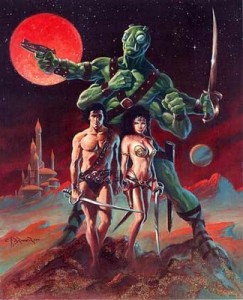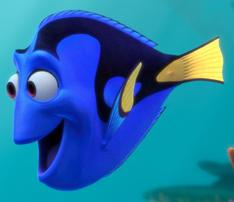Adventure
99
If you know anything about John Carter, you know he can jump. That’s his thing. He’s like the Flash for jumpers. A shame, since the Flash is a one-trick pony, and John Carter is so much more.
John Carter of Mars, who first debuted in the novel A Princess of Mars, is essentially the Superman story in reverse. Superman grew up on a steady diet of red Krypton sun, which is sort of like the acai berries of suns. When he hit the yellow sun of earth, he transformed from an ordinary baby to a god among men.
Similarly, John Carter is a simple Virginia gentleman who finds himself transported to a world called Barsoom (Martian word for “Mars”), where his exposure to Earth’s dense gravity and his sharply trimmed mustache makes him a god among men. It is not uncommon for John Carter to leap 50 feet straight up in the air with little effort.
But John Carter is more than just an adventurer with mad hops. The story opens with a prelude by author Edgar Rice Burroughs, detailing his “discovery” of the “manuscript” of his “uncle” John Carter while “visiting” the Carter homestead. By using this sort of “found footage” gimmick, Burroughs predates the Blair Witch Project by 80 years.
Carter’s tale begins with an Old West adventure yarn, continues on through the discovery of a gold vein, and proceeds with Carter fleeing from a band of murderous Apaches who have already killed his partner. John Carter discovers a hidden cave in the sheer side of a cliff, hides there, and vows to make his last stand. Even if the story had stopped right here, it might still make our list of 100 Extraordinary Adventures.
But like all strange caves, this one is a portal to another dimension. When John wakes up, he finds himself at the hatching grounds of the “green men of Mars.” These Martians are barbaric warriors, six-limbed green giants with no interest in frozen vegetables. The finer points of humanity — friendship, love, ridiculous jumping skills — are unknown to them. But John earns a place as one of their chieftains by besting them in battle.
It should be noted that jumping plays only a moderate role in his fighting skills. It is true that he is afforded superhuman strength by virtue of Mars’ lesser gravity, but John Carter is a first-rate brawler even without those powers. It is not long before the green men are in awe of him. Not only does he fight like a strung-out tree toad, but he is also able to tame wild Martian stallions and befriend ferocious Martian dogs through use of his secret weapon: Kindness. He wins a few allies, but makes more enemies, and soon John Carter is banished into the Martian wilderness.
It is here that the story heats up, for John actually meets a princess of the red race of Mars, whose name is not Lois Lane, nor is it Pocahontas. If you really must know, her name is Dejah Thoris. Her people are very humanoid, and soon John is headlong in the first interspecies romance of the sci-fi era.
As a love story, you will recognize all the elements: A meet-cute, some early bickering, forbidden love, the princess promised to another, and an epic battle with John teaching the green men how to get along with the red men, with or without Kevin Costner’s help. It should come as no surprise that John wins the princess’s hand and vanquishes an invading force by use of his massive fleet of flying ships (oh yeah, forgot to mention that he has captured a massive fleet of flying ships).
And it is here, at the end of the book, that John Carter of Mars takes a turn for the strange.
Yes, a Virginian grasshopper flitting around on an alien planet, dating red chicks and capturing giant airships is par for the course. But when it comes to the nail-biting cliffhanger endings, Edgar Rice Burroughs is off the reservation. Keep a weather eye about you, matey. There be spoilers ahead.
The last few pages of the book gloss over John’s remaining 10 years on Mars. He and Dejah are happy, of course, and I’m sure John does many marvelous things, like curing Barsoomian cancer and standardizing the planetary currency. But right at the end of the book, disaster strikes.
Apparently Mars has giant atmospheric pumping stations to purify the air, and these are hidden in the Martian wilderness and can only opened up by the Martian equivalent of a secret handshake (thought waves of color projected at the door, as if you didn’t already know). Unfortunately, the plant has failed, meaning the entire planet is suffocating to death. If this sounds like the ending to Stephen King’s Under the Dome, then maybe imitation really is the sincerest form of flattery.
John, of course, knows the secret handshake, having stumbled onto the plant during his wanderings in the Martian wilderness. As Martians are dropping dead all around him, he races aboard a speederbike to the plant’s back door, and with the help of some Ewoks, just manages to transmit the necessary thought waves that open the door before he collapses from asphyxia. He coughs instructions to a sentry for restarting the plant, but passes out as the sentry runs through the halls.
When John regains consciousness, he is back in the desert cave on Earth. Mars is a million miles away, and John is left to wonder if the planet (in other words, his girlfriend) has been saved or not.
Yes, that’s really the ending.
Edgar Rice Burroughs went on to “discover” many more of John Carter’s “real” adventures, and it resulted in an epic 11-volume collection, some of which are almost as famous as this first story. There have been many attempts to turn the story into a movie, but when only films that star Traci Lords actually cross the finish line, you’re not really looking at high art. It is said that the John Carter story was a heavy influence for Avatar, but that movie’s plot is so utterly and completely original that I find it hard to believe anyone could suggest this.
Hope remains on the horizon in the form of Andrew Stanton of Pixar (director of Finding Nemo and Wall-E). If Stanton’s reputation is any indication, his upcoming film will mark the first time John Carter has successfully transcended his pulp fiction and comic book roots, and also the first time anyone seriously considered Ellen Degeneres for the role of a sci-fi princess.
Next up on our list… #98.







